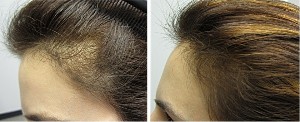Update 2019: Perhaps Strip (FUT) will never die out as long as hair transplants exist?
Until 2010 or so, strip hair transplants (also known as follicular unit transplantation — FUT), were by far the dominant form of hair transplants offered by surgeons across the world. However, in spite of major improvements in technique making the strip scars at the back of patients’ heads fairly compact and slim, this method was still unacceptable to many people and seemed crude. In my opinion, a better name for them would be “strip excision and scalp restitching” hair transplants.
Disadvantages of Strip Hair Transplants
Even the best strip hair transplant surgeons in the world saw unacceptable results on rare occasions. Individual patients’ scalp laxity and skin color often affecting outcomes in unpredictable ways.
I remember reading forums posts from one patient in particular who went to a clinic with an extremely good online reputation becoming desperate due to major lingering pain and nerve damage at the back of his scalp from where the strip was removed.
In many cases, patients lose more hair as they age and decide to shave their head. In those cases, a strip scar at the back of a shaved head can look very bad if it has stretched or distorted after surgery.
FUE Hair Transplants Become Popular
Luckily, over the past decade and a half, follicular unit extraction (FUE) has become increasingly popular. FUE was first described by Dr. Masumi Inaba of Japan in the 1980s, but it was Dr. Ray Woods of Australia who popularized it in the 1990s.
Starting around 2005 or so, I began noticing an increasing number of hair transplant surgeons worldwide adding the FUE technique to their practice. Some totally stopped offering strip FUT procedures, although most seemed to offer both. In general, the FUE technique is more time consuming and requires more specialized skills than the common strip procedure. Therefore, all hair transplant surgeons charge a higher rate per graft for FUE in comparison to FUT.
Since 2010, an increasing number of hair transplant surgeons have become almost exclusively FUE practitioners. Even more groundbreaking is the fact that many surgeons are now using the ARTAS robot for the actual follicular unit extraction.
I feel like this is a great thing, since there was major variance in: technique; consistency; graft survival; punch size; and associated scarring when it came to FUE extractions prior to the arrival of this robot. The automation will hopefully standardize extractions and make worst case scenarios from inexperienced FUE surgeons a lot more palatable.
Two Recent Developments Indicating Impending FUE Dominance
1) In 2013, I was reading the contents of the ISHRS 21st annual meeting program guide pdf, and got a major surprise when I read the following from Dr. Robert True:
FUE has emerged, and in the minds of many, will soon replace FUT as the hair transplant procedure of choice.
It is quite amazing that in the first ISHRS meeting in 1999, FUE was not even mentioned! This is all the more reason to avoid taking hair transplant surgeon skepticism about hair cloning and hair multiplication very seriously. Change is hard, and especially so if it can make a negative impact to your wallet and career.
2) Another major development just occurred this past week, when Joe Tillman (aka Jotronic) of the very popular Hasson & Wong (H&W) clinic in Canada announced his move to now being the representative of Dr. Hussain Rahal (also of Canada). This was a complete shock to me and most other hair loss forum regular visitors.
Prior to the shift, Joe had worked for H&W for over a decade, and was in all likelihood the main factor in their tremendous online marketing success. In recent years, many people had asked Joe why H&W was not offering FUE, and Joe always seemed to argue in favor of the merits of the strip technique as practiced by his clinic.
H&W’s numerous well presented online results and testimonials combined with small final strip scar photos made it hard to fault Joe’s opinion. However, if I was getting a hair transplant, I would never go for the strip excision procedure. So I was pleasantly surprised when Joe announced his move to Dr. Rahal, who seems to offer both FUE and FUT hair transplants.
I look forward to reading more from Jotronic in the coming days about his feelings on FUE versus FUT (aka strip), as well as on his reasoning behind this major move. I have no doubt that Dr. Rahal will see a surge in new business hereon.
